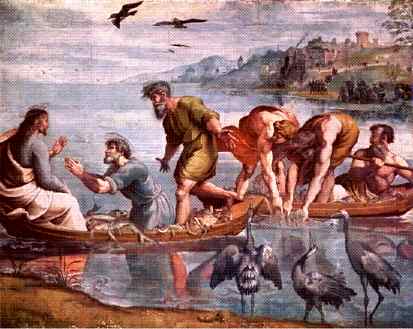High Renaissance: Raphael
The works of Michaelangelo, Leonardo da Vinci and Raphael are usually considered to be the high point in Renaissance art.
Raphael's work was certainly known in England, for a copy of tapestries designed by him were given to Henry VIII. The original tapestries were hung in the Sistine Chapel, and were designed to complement the well-known paintings by Michaelangelo. Raphael composed them in such a way that they took advantage of the natural lighting in the Chapel, with the apparent source of light in the tapestries coming from actual windows.
The "cartoons,*" or sketches from which the tapestries were made, pictured miracles from the life of Christ.
Read about the Biblical story* it portrays.
Why is the reflection of Christ's gown so pink?*
All done with mirrors?
The technique of taking the patterns for the tapestries from the Cartoon meant that the finished picture would be a mirror image of the original sketch, with the result that Raphael had to create images that would be reversed in the final version.
It may seem that this would make little difference, but educated western viewers of any image will tend to see movement from left to right more vividly than from right to left because the eye is trained to see in the direction of reading; thus when the images are in their final orientation they are more dramatic, less static.
To see the difference with the cartoon on this page, click here to see it in reversed view.
Footnotes
-
The Cartoons in England
The English connection with the Cartoons is strong; not only was there a copy of the original tapestries in the possession of Henry VIII, but the Cartoons themselves were acquired by Charles I in 1619, three years after Shakespeare's death, and have remained in England ever since.
-
The miracle
The miracle represented here is of the "miraculous draught of fishes" (Matthew 12:24) when the Disciples were told by Jesus where to fish after a fruitless day's work.
In the Cartoon, notice the use Raphael makes of groups of threes: three figures on the left, three on the right, three herons. All movement portrayed in the painting draws the eye to the left where Jesus is.
-
Pink and red
The reflection of Christ's gown is a deep shade of pink, while his actual cloak above is very pale. This seeming oddity is the result of the pigments fading after much use; both were originally red. The Cartoons in their present form consist of many squares made to overlap; the tapestry makers divided the work into smaller parts, and used pins to mark the edges of lines.
Even after much use, the Cartoons preserve the balance and beauty of Raphael's concept.
